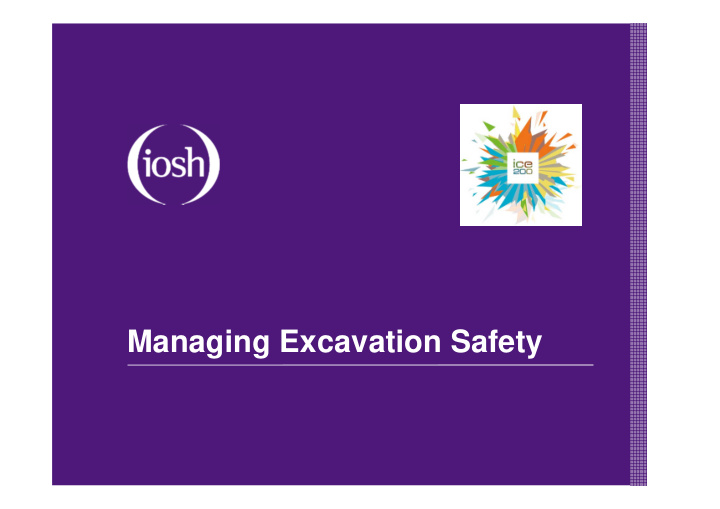



Managing Excavation Safety
Introduction Heath McHugh CMIOSH Health & Safety Manager (MGF) David McNair BEng (Hons) EngTech MICE Senior Design Engineer (MGF) Scott Ellis Group H&S Manager Eric Wright
Agenda What is Temporary Works? • Why are Temporary Works Required? • Temporary Works Management • Temporary Works Process • Impact of a Poor Brief • Benefits of a Good Brief •
What is Temporary Works?
Who are MGF?
Why Excavate?
Why are TW’s required?
Why are TW’s required?
TW’s Process
Stage 1: Planning & Investigation
Stage 1: Planning & Investigation
Stage 1: Planning & Investigation How many hazards can be identified? 4 1. Geometry - Embankment 7 2. Structure - Building 2 3. Structure – Retaining Wall 1 4. Environment – Tree 5 5. Structure – Boundary Wall 3 6. Infrastructure - Highway 6 7. Body of Water – Pond?
Stage 1: Planning & Investigation Identifying Hazards – Annotated Photos
Stage 1: Planning & Investigation
Stage 2: Design
Stage 2: Design
Stage 2: Design
Stage 2: Design
Stage 2: Design
Stage 3: Construction
Overview of MGF Design Process
Impact of Poor Information Longer Design Process Cautious Design Approach Revisions Operational Change / Frustrations Increased Cost Strained Relationships (Internally & Externally)
Impact of Getting it Wrong
Benefits of Good Information Value Engineered Solution Time (Delivery) Time (Programme) Economical Solutions No Revisions Required Satisfied Customer / Client
What Good Looks Like
Edge Protection
Emergency Rescue
Programme Planning - process Construction Phase • Temporary works • Safe digging practice management • Trench support installation • Site investigation • Inspection • Confined space • Safe working • Risk assessment • Emergency arrangements • Competence • Back fill / reinstatement • Work area • Work method Review
Planning
Risk assessment
Avoiding underground services Planning & prep • Competent staff & workers • Current drawings (3 month) • CAT & Genny • Mark up • Hand dug trial holes (backfill with sand) • Permit to dig Safe digging practice • Insulated tools & AR overalls • 500mm rule • Don’t dig down on mark up
Confined space?
Confined space?
Confined space? Risk Assessment Avoid Manage the risk Competent people Emergency arrangements
Logistics & Segregation of works
Deliveries & storage
Trench support installation Equipment on site & ready for use Competent installers Following a plan
Types of shoring � Sheets & frame Boxes �
Trench support
Battering / stepping back
Permit to proceed Permit to proceed Completed by the TWC Part 3 Permit to strike
Inspection Before each shift After any event likely to affect its stability After any earth fall or fall of material
Permit to proceed Part 3 Permit to strike
Emergency arrangements We must have and practice an emergency evacuation We cannot rely on the emergency services!
Permit to proceed Part 3 Permit to strike
Backfill & reinstatement Surcharge Stop blocks Damage to services Density / settlement
Review We don’t do enough of this What went well & what never!
Summary – we’ve looked at Planning - process Construction Phase • Temporary works management • Safe digging practice • Site investigation • Contamination • Trench support installation • Ground water • Ground strata • Inspection Design process • Safe working • Confined space • Back fill / reinstatement • Risk assessment • Competence Review • Work area • Work method
Thank you Heath McHugh David McNair Any questions? I would like to thank our sponsors today MGF (link) M&P Surveys (link)
Recommend
More recommend